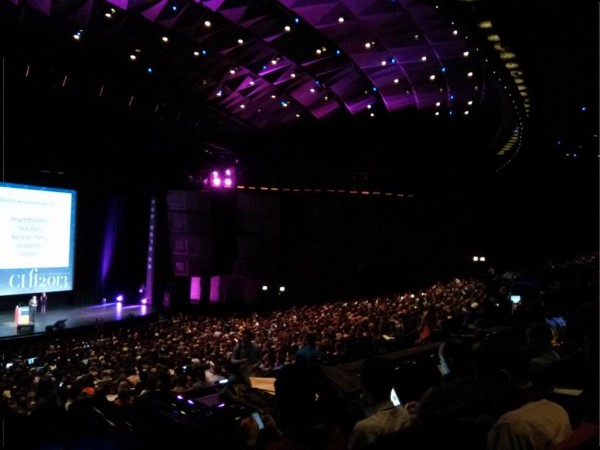ACM is widely recognized as the premier membership organization for computing professionals, delivering resources that advance computing as a science and a profession; enable professional development; and promote policies and research that benefit society.
SIGCHI is the premier international society for professionals, academics and students who are interested in human-technology & human-computer interaction (HCI).
The ACM SIGCHI Conference on Human Factors in Computing Systems is the premier international conference on human-computer interaction.
Multiple sessions in parallele were recorded at the last CHI 2013 conference in Paris using Triskel webcasting platform.

CHI 2013 Opening session

#chi2013 was the largest CHI ever. 3378 attendees
CHI 2013 was about changing perspectives: researchers draw from the constantly changing perspectives of the diverse CHI community and beyond, but they also change perspectives, offering new visions of people interacting with technology. The conference is multidisciplinary, drawing from science, engineering and design, with contributions from research and industry in 15 different venues. CHI brings together students and experts from over 60 countries, representing different cultures and different application areas, whose diverse perspectives influence each other.
General Conference Chair: Wendy E. Mackay, Research Director, INSITU lab, INRIA, France.
Technical Program Co-Chair: Patrick Baudisch, Professor, Hasso Plattner Institute, Germany.
Technical Program Co-Chair: Michel Beaudouin-Lafon, Professor, Université Paris-Sud, France.
Communities
- Design: Design Community is one of the most successful and visible communities at CHI. The focus of CHI 2013 is on the centrality of experience—from the models, theories and practical insights we need to understand and design for user experience to the irreplaceable value of experiencing innovation in our field through hands-on interactivity.
- Engineering : In HCI, engineering approaches are broad, but have three major areas of development and application: (1) structured methodologies for interactive system design and evaluation that will enable the more rapid, consistent and reliable development of new interactive systems; (2) methods, processes, languages, models and tools to support the application of scientific knowledge of human characteristics to improve interactive systems; (3) new software and hardware technologies that enable effective solutions to design problems. These areas share the engineering values of rigour, appropriate quantification, and a concern for practical effectiveness.
- Management: Managers are a key component in the CHI ecosystem. Without managers, there would be no one to hire students, build teams, and deliver well-designed and highly usable products. The Management Community has been a growing focus at CHI conferences and within the SIGCHI organization.
- User Experience: The User Experience Community aims to serve CHI contributors and participants interested in usability and user experience (UX) – studying both the utilitarian and experiential (or instrumental and non-instrumental, if you like) aspects of human-technology interaction.
- Child-Computer Interaction: Our interest includes children across all ages, from toddlers to teenagers and contexts including home, school and play, fun, learning and sociality, and education, games and communication.
- Digital Arts: Through CHI, artists can learn of technological advances and engage in discourse about these technologies. By providing a platform for digital arts at CHI, we can facilitate interdisciplinary collaboration between artists and technologists, and additional insights can be gained in turn.
- Games & Entertainment: Games and Entertainment are part of our daily lives, and represent a growing segment of practice for our field. In contrast to work-oriented information systems, games and entertainment applications are not necessarily task oriented; successful user experience in games transcends and sometimes even contradicts traditional usability guidelines. Player-centered development requires adjustment of existing design and evaluation methods and development of new ones.
- Health: For some, health begins at home, is preventive, and uses a holistic approach including nutrition, exercise, and mental and emotional well-being. For others, the greatest concerns may be centered on acute care and hospital settings. For still others, health means tackling human development, growth, and eventually decline. Interactive systems for health, therefore, can include assistive technologies, personal informatics and persuasive technologies, clinical systems, home healthcare devices and communication technologies, telemedicine, and much more.
- Sustainability: Our goal is to create a sense of community for those who contribute and attend the conference who are interested in issues of sustainability—not just issues of environmental sustainability, but also issues of the implications of our design and use of interactive technologies within and beyond HCI for climate change mitigation and adaptation, health, regional concerns especially coastal regions, food, ecosystems, water, as well as economic systems, reducing consumption, re-constructing business practices, and more. We specifically invite you to think beyond individual behaviors to consider HCI and interaction design’s roles and potential roles in changing the foundations of how we as societies use and conserve the Earth’s precious balance of resources.
- HCI4D: The HCI4D community welcomes everyone who is interested in the role of technology in diverse domains such as, but not limited to: conflict zones; early-grade reading; infant mortality; rural and urban community development; strengthening human institutions; and resource-constrained, disenfranchised and marginalized populations.
You may have a look at those sketches from Makayla Lewis summarizing some of the sessions:
Other related links:
Visualization Papers at CHI 2013
Another interesting sketch, about innovation.
A CHI 2013 trip report by Paul Groth
Folks to follow:
Paolo Ciuccarelli @pciuccarelli




